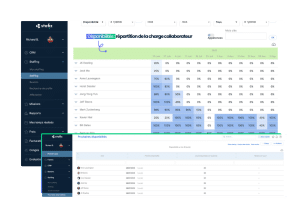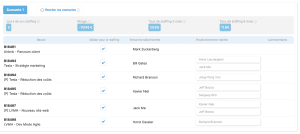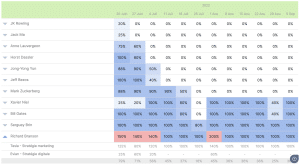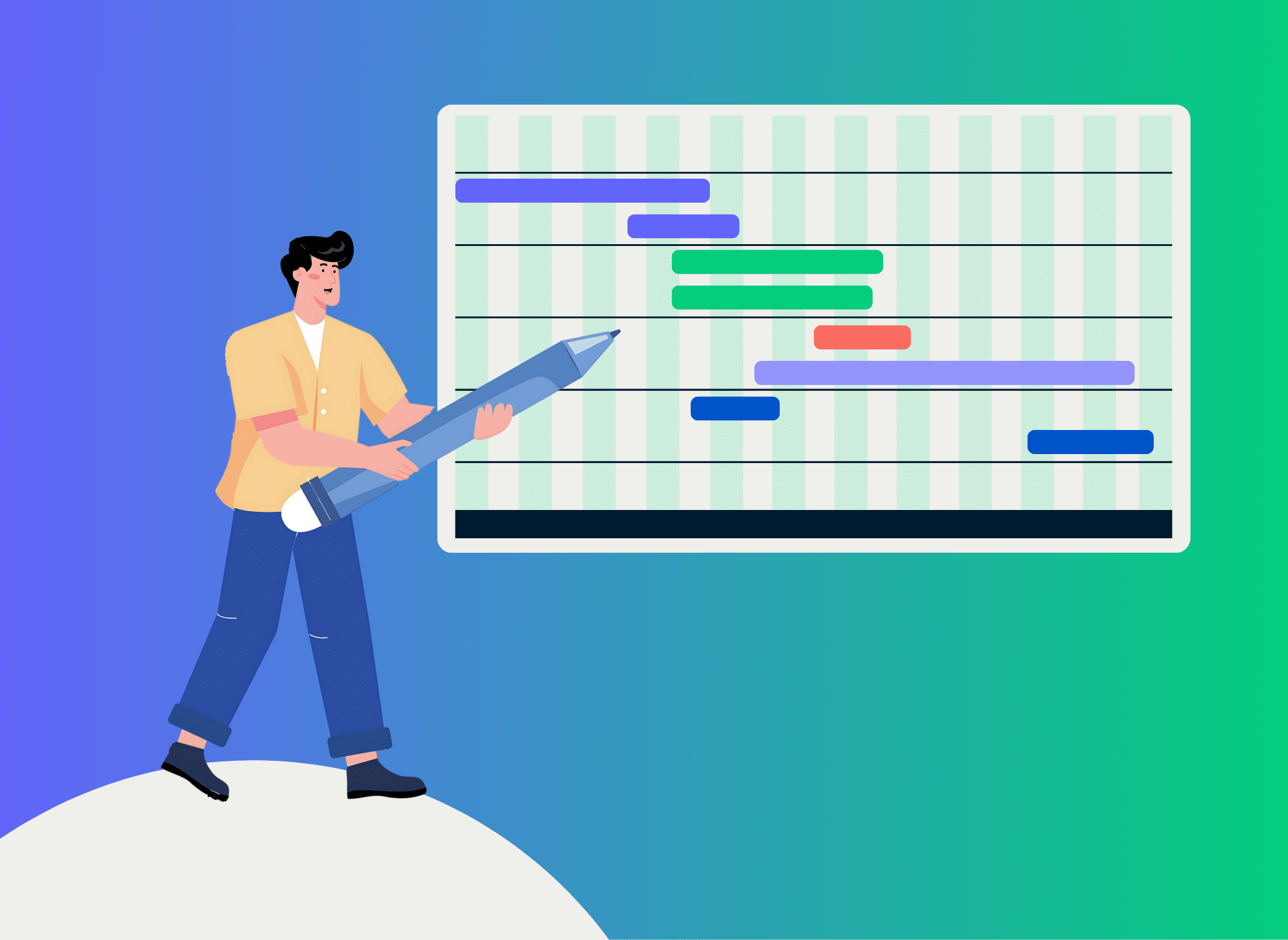Top 6 des fonctionnalités à rechercher dans un logiciel de planification

Le logiciel de planification est l’allié des projets à succès. Il permet en effet un pilotage centralisé de tous les éléments permettant la bonne exécution de vos missions. Par ailleurs, un bon outil de planification est capable de vous aider à garder le contrôle de vos finances.
Pour vous guider dans votre choix, on vous partage notre checklist des fonctionnalités primordiales d’un logiciel de planification projet.
Pourquoi investir dans un logiciel de planification ?
Tout comme un artisan ne peut travailler sans outil, la gestion de projet est un art bien plus florissant lorsque les équipes concernées sont équipées.
Quels enjeux pour les entreprises de service ?
L’adoption d’un logiciel de planification projet répond à trois enjeux principaux :
- la visibilité,
- la productivité,
- la rentabilité.
Cette sainte trinité du management de projet doit être satisfaite afin de garantir la pérennité de votre entreprise.
Optimiser l’allocation de vos ressources est un challenge gratifiant, puisqu’il permet d’augmenter vos marges grâce à une productivité décuplée. Mais pour ce faire, l’accès à une visibilité sur les ressources et les compétences disponibles – et à quel niveau – est indispensable.
C’est là qu’entre en jeu le logiciel de planning projet. Les données sont mises à jours régulièrement et permettent un niveau d’information égal pour toutes les parties prenantes. Du moins, à condition que l’outil choisi soit assez collaboratif pour mettre en relation les équipes et la direction.
Excel pour la gestion de projet : suffisant ou désuet ?
Si Excel est un bon compagnon pour démarrer une activité, il devient rapidement un fardeau. Pire, un obstacle à votre croissance.
Pour cause, un manque d’automatisations qui vous oblige à réaliser des opérations manuelles, et une probable double saisie sur vos logiciels de travail. Cela est non seulement chronophage, mais également vecteur de risques. Excel ne permet pas d’intégrer nativement les changements de planning ou de budget, par exemple. Un oubli ou une erreur de saisie peut provoquer un effet boule de neige dont vous vous passeriez volontiers…
Enfin, une planification de projet sur Excel ou Google Sheets vous oblige à constamment garder un œil sur la planification. Et gare à vous et à vos collègues ! Un manque de communication entraîne des confusions – et des retards, puisque vos collaborateurs ne seront pas forcément avertis des modifications prévues.
Cas d’usage : les gains liés à l’adoption d’un logiciel de planification
Youmeo est un cabinet de conseil en innovation d’une vingtaine de collaborateurs.
La société utilisait Excel pour gérer leurs missions, notamment concernant :
- les ressources,
- les notes de frais,
- les congés.
Côté facturation, l’entreprise les rédigeait manuellement.
Une situation peu optimale, qui a fini par avoir des conséquences. Travail produit non facturé, frais non traités… Les tâches administratives prenaient trop de place, sans pour autant garantir un résultat sans erreur.
En choisissant Stafiz comme logiciel de planification, Youmeo a réussi à améliorer sa rentabilité grâce à une meilleure gestion. Alors pourquoi pas vous ?
Le temps d’un collaborateur confirmé est finalement utilisé pour une autre mission. Il est alors remplacé par un profil junior à compétences égales. Le prévisionnel, le rapport de rentabilité et le planning de la charge sont alors automatiquement mis à jour.

Ainsi centralisées, les données sont plus fiables car elles sont constamment mises à jour. Vous gagnez du temps et réduisez les tâches administratives : vos équipes sont plus engagées !
La gestion multi projet
La planification de vos projets ne doit pas mettre en péril la gestion de votre portfolio. Optez donc pour un logiciel avec une visibilité sur le portefeuille de projets.
Stafiz vous permet notamment de visualiser votre rentabilité à la fois sur l’ensemble du portfolio, mais aussi mission par mission. Cette vision vous permet un pilotage stratégique des priorisations à effectuer.

Ainsi, vous pouvez prendre de meilleures décisions quant aux planning de certains projet – et y intervertir des collaborateurs par exemple – mais aussi garder le contrôle sur les coûts afin de sécuriser vos marges et la trésorerie.
Fonctionnalité n°2 : Gestion des ressources et visibilité en temps réel
Visibilité sur la charge et les disponibilités
Un bon logiciel de planification permet d’avoir une visibilité immédiate sur les ressources disponibles, et permet de faire des recherches (par compétence, expérience) pour identifier les profils les plus adaptés. Une bonne visibilité sur le charge pour identifier les problématiques de sous-charge et surcharge.

Côté équipe projet et consultants, cela permet de mieux anticiper sa propre charge et d’éviter les re-planifications de dernière minute qui peuvent entraîner des retards.
Suivi des disponibilités et des absences
Certains paramètres, comme le fait de pouvoir bloquer l’affectation des ressources sur les temps non disponibles, contribuent à garder le bon niveau d’information accessible. Vous réduisez ainsi le risque de conflits de ressources et favorisez le pilotage global des ressources.
Le logiciel choisi doit alors intégrer un système de gestion des congés et des absences, mais pas que. Stafiz propose notamment de paramètre de quota journalier. Ainsi, un collaborateur ayant un contrat de 35h ne pourra pas être affecté à des tâches au-delà de la limite de 7 heures par jour. Vous pouvez ainsi adapter votre planification de projet sur vos différents types de contrat, même les mi-temps.
Découvrir la gestion des congés dans Stafiz
Allocation des ressources humaines sur les projets
Pour affecter vos ressources plus rapidement sur vos tâches ou projets, privilégiez un logiciel doté d’un moteur de recherche.
- Le moteur de recherche
Celui de Stafiz est hautement personnalisable : tout les champs renseignés dans les CV ou les profils utilisateur peuvent devenir des mots clés.
Ainsi, lors de l’affectation des ressources, il vous suffit de taper la compétence recherchée et de renseigner le niveau attendu.

Vous pouvez ensuite enregistrer votre recherche comme un besoin pour l’utiliser plus tard.
- La gestion des besoins
Comme vu précédemment, l’intégration de la gestion des besoins à un logiciel de planification est un énorme bonus.

La gestion des besoins dans Stafiz
En enregistrant un besoin en compétence depuis le moteur de recherche ou directement dans la mission, vous êtes en mesure d’anticiper la planification de la capacité. Cette approche long terme est un atout pour votre activité. Vous êtes en effet plus apte à prévoir la prévision des besoins en ressources, et par conséquent, à remporter plus d’opportunités commerciales.
- Le pré-staffing
Cette fonctionnalité vous permet de pré-positionner les consultants avant de finaliser le staffing. Cela vous permet notamment de prévoir plusieurs profils pour un même besoin, vous offrant plus de flexibilité. De plus, l’analyse de la charge étant recalculée, il vous sera plus facile d’arbitrer sur les positionnements en optimisant l’occupation.
Dans certains cas, cela peut également servir en avant-vente, notamment comme support de proposition au client. Courant chez les ESN, cette pratique mise à rassurer le prospect sur la qualité attendue et les délais.
- La simulation de scénarios
Quoi de plus fiable que l’analyse par la donnée ? Un logiciel de planning projet doté d’un outil de simulation vous économisera de nombreuses réunions !
Le Scenario Builder de Stafiz est une technologie puissante. Il propose différents scénarios d’affectation pour vous aider à trouver la solution la plus profitable. Il s’appuie sur les besoins (en tâches, et donc en compétences), et les ressources.
Le meilleur scénario sera alors élu en fonction de 4 critères : la marge, les jours de surcharge, le TACE à 3 et à 6 mois.

Exemple de simulation de scénario d’affectation des ressources dans Stafiz
- Intégration de la sous-traitance
Le travail avec des freelances dépasse souvent la frontière de vos outils de travail. Pourtant, cette collaboration pourrait être simplifiée.
Vérifiez que le logiciel retenu propose d’intégrer votre sous-traitance à vos processus de travail, par le biais de création de profils utilisateurs temporaires, ou avec différents niveaux d’accès. Vous gagnerez en rapidité et en efficacité.
- Gestion de la charge
Le manque de visibilité sur la charge est un réel enjeu. Vous devriez être en mesure de constater la charge actuelle et à venir des collaborateurs que vous affectez sur des missions. Si votre logiciel actuel ne vous le permet pas, il est tant de faire une mise à niveau !
Voici un planning d’équipe dans Stafiz. Les collaborateurs dont la charge hebdomadaire est supérieure à 100% sont affichés en rouge. De même, un employé sous-chargé apparaîtra dans un bleu plus clair. Ces indications sur la charge sont disponibles à tout instant de planification.

Vous pouvez d’ailleurs équilibrer la charge de travail directement depuis cet écran. Il vous suffit de dérouler un utilisateur pour obtenir le détail de la répartition de sa charge.
En suivant la charge de près, vous maximisez l’occupation de vos équipes pour garantir un taux d’occupation optimal et réduire les temps non facturables. Il s’agit là d’un bon moyen d’anticiper les besoins de recrutement et de prévenir le burnout.
Fonctionnalité n°3 : Suivi des livrables et des jalons
Clarté des livrables attendus
La gestion des livrables du projet est un véritable fil conducteur. Souvent associés à des jalons, ils formalisent le passage à une autre phase ou tâche.
Un bon outil de planification des projets intègre une gestion des documents pour faciliter le partage des livrables. Stafiz va plus loin et vous propose de configurer vos livrables comme jalon. De ce fait, lorsqu’un livrable est partagé et déclaré comme achevé, cela permet d’activer automatiquement certains processus, comme le passage à la phase suivante, ou le déclenchement d’une facture.
Définition d’échéances, de responsables, de status
Un suivi clair nécessite des indications claires.
Votre plateforme de planification de projet doit mettre en lumière les dates butoires des tâches ou des phases. De même, leur attribuer un responsable est une façon d’indiquer aux différentes parties l’interlocuteur à privilégier en cas de besoin.
Ainsi, chaque membre de l’équipe est au clair avec ses propres missions, et avec l’état d’avancement général du projet.
Fonctionnalité n°4 : Collaboration et notifications
Vos journées de travail seront bien plus efficaces si vos outils se prêtent à la collaboration. L’objectif est de réduire les réunions et leur durée autant que possible, ainsi que les échanges de mails, qui passent parfois inaperçus et entraînent des confusions.
Communications in-app
Privilégiez donc un outil capable d’être utilisé comme canal d’échange.
Des fonctionnalités comme la messagerie instantanée ou l’ajout de commentaires ne sont pas négligeables pour éviter les silos de communication.
Pouvoir partager une tâche ou un écran directement par un lien fluidifie également le travail et permet de donner du contexte. Si cela vous semble pertinent, optez plutôt pour un logiciel de planification SaaS.
Systèmes d’alertes
Pouvoir être notifié en cas de modification de planning est également un excellent moyen d’automatiser la collaboration, mais pas que. En effet, un logiciel comme Stafiz vous permet un haut niveau de personnalisation d’alertes afin de décharger votre suivi.
Vous pouvez par exemple être alerté en cas de déviations à venir, qu’il s’agisse de la production, des délais ou des coûts. Vous bénéficiez alors d’un suivi constant, tout en réduisant le temps passé à analyser et suivre vos dashboards.
Meilleure synchronisation entre équipe projet et management
Les allers et venus de documents à faire valider sont courants, et deviennent vite un frein à la productivité.
Votre outil doit pouvoir intégrer des workflows de validation personnalisables selon vos besoins. Cela réduira considérablement le temps de réponse entre la validation et la livraison.
Fonctionnalité n°5 : Reporting et indicateurs de pilotage
Dashboards personnalisables
Lors de la planification d’un projet, vous souhaitez pouvoir suivre la répartition de la charge, l’état d’avancement du projet et la consommation du budget.
Assurez-vous que votre outil intègre les fonctionnalités suivantes pour vos tableaux de bords de projet :
- la prise en charge du modèle de facturation adéquat (régie, forfait ou les deux),
- le suivi prévisionnel et en temps réel des projets,
- une interface modulable qui s’adapte à vos différents types de projets,
- différents droits d’accès, pour protéger les données sensibles et éviter de surcharger l’affichage d’employés non concernés.
Suivi des écarts
La planification de projet n’est jamais réellement terminée. C’est pourquoi votre logiciel doit prévoir des fonctionnalités de suivi des écarts. De cette façon, vous pouvez analyser les déviations en direct ou avant qu’elles n’aient lieu, et rectifier les plannings pour optimiser votre marge.

Vous pouvez ainsi identifier ce qui a posé problème et sécuriser la rentabilité. Pour vos futurs projets, vous pourrez apprendre des précédents échecs afin de ne retenir que le meilleur.
KPI essentiels pour les directions de projet et des finances
Enfin, pour que vos tableaux de bords soient activables, le logiciel doit être en mesure de calculer et d’afficher différents types de KPI.
- Les KPI de rentabilité
Il s’agit des indicateurs financiers liés à un projet.
| Montant brut vendu | Montant officiel de la mission, normalement la somme des bons de commande |
| Part facturée | Montant facturé divisé par le montant brut vendu |
| Restant à facturer | Montant brut vendu, moins le montant facturé |
| Marge brute | Marge brute à la fin de la mission, incluant le staffing |
| Marge attendue | Marge attendue à la fin de la mission, incluant le futur |
| Jours réalisés | Nombre de jours de temps réalisés, incluant les jours des sous-traitants et les produits |
| Jours de staffing | Nombre de jours de staffing, incluant les jours des sous-traitants et les produits |
| Réalisé non facturé | Valorisation des temps réalisés (incluant les sous-traitants et produits) pour le passé, moins le montant facturé. Ce réalisé non facturé correspond aux FAE / PCA (facturation à émettre / produits constatés d’avance) |
| Valeur des temps réalisés | Valorisation des temps réalisés (incluant les sous-traitants et produits) pour le passé |
- Les KPI de projet
| Taux de réalisation | Mesure de la rentabilité d’une mission au forfait en comparant le montant vendu à ce qu’il aurait dû être pour atteindre l’objectif fixé |
| Montant brut vendu | Montant officiel de la mission, normalement la somme des bons de commande |
| CA | Total des ventes réalisées par une entreprise, calculé en fonction des missions au forfait et en régie |
| Restant à produire | Montant vendu moins la production passée valorisée, multiplié par le taux de réalisation |
| Production facturée par avance | Production valorisée × Taux de réalisation |
| Total facturé | Total hors taxe des factures émises sur la mission |
| Avancement | Pourcentage de réalisation d’une mission par rapport à son objectif final |
| Production valorisée | Valorisation des temps sur la base des taux du plan de production |
- les KPI de direction financière
| Compte de résultats | Vision du chiffre d’affaires, calculée sur la base du facturé pour les missions en régie et sur l’avancement par les coûts pour les missions au forfait |
| Rapport de production | Valorisation de l’ensemble des jours sur chaque projet, basé sur les taux inscrits dans le plan de production |
| Rapport de commandes | Bons de commande signés, avec une répartition par dates officielles de vente ou de projet |
Fonctionnalité n°6 : Intégrations avec vos outils métiers
Le dernier critère de choix pour votre outil de planification concerne les intégrations qu’il propose. Qu’il s’agisse d’API ou de connecteurs natifs, ces derniers sont indispensables pour faire communiquer vos logiciels entre eux.
Considérez les possibilités suivantes :
- intégration au CRM,
- intégration à l’ERP,
- intégration au SIRH et autres outils RH,
- intégration à vos agendas.
Les qualités transversales à rechercher dans un outil de planification projet
Au-delà du besoin en fonctionnalités techniques, l’outil sélectionné doit également remplir certaines cases pour convaincre, et faciliter son adoption.
Son interface utilisateur doit être pensée pour faciliter la collaboration. Plus un outil sera intuitif et facile à prendre en main, plus vous limitez les risques de rejet.
Quelles fonctions ou modules vous permettent de rester pro-actif ? De déléguer certaines tâches grâce à l’automatisation ? L’idée est avant tout de trouver un logiciel capable de s’adapter à vos méthodes, et ce, dans un environnement mouvant.
Un bon logiciel de planification doit donc contenir des fonctionnalités :
- de visualisation,
- de gestion des ressources,
- de gestion et de suivi des temps,
- de collaboration,
- de reporting.
- d’intégrations.
Il doit pouvoir s’adapter non seulement à une planification changeante au fil de la mission, mais également aux types de projets que vous pourriez remporter.
Questions fréquentes :
La planification permet d’anticiper, d’organiser et de suivre la réalisation des tâches, ressources et délais dans un projet. Elle vise à optimiser l’allocation des ressources (temps, compétences, budgets), à visualiser les dépendances entre activités, à identifier les risques et à garantir que les livrables seront produits dans les temps.
Le bon logiciel dépend des besoins spécifiques de l’entreprise : nombre de projets à gérer, volume de ressources humaines, complexité des plannings, collaboration multi-équipes, intégration avec d’autres outils (facturation, CRM, RH…). Priorisez les fonctionnalités clés comme la visualisation Gantt, la planification multi-projets, les alertes de charge, ou encore les rapports automatiques.
Il n’y a pas de réponse universelle, mais pour les sociétés de services (conseil, ESN, agences), les meilleurs outils sont ceux qui allient planification des missions, gestion de la charge des collaborateurs, suivi du temps et rentabilité. Des solutions comme Stafiz, Forecast.app, Scoro ou Monday.com sont souvent citées pour leurs fonctions orientées gestion de projets et staffing.
Non, mais il peut en faire partie. Un logiciel de planification se concentre sur la gestion du temps, des ressources et des calendriers. Un outil de gestion de projet est plus large : il inclut la planification mais aussi la gestion des risques, des budgets, des livrables, de la communication et du pilotage global. Certains logiciels intègrent les deux volets.
Il permet de gagner en visibilité sur l’ensemble des projets en cours, d’anticiper les conflits de ressources, d’améliorer la productivité et de mieux respecter les délais. Pour les sociétés de services, c’est aussi un levier de rentabilité grâce à l’optimisation du temps facturable et de la planification des talents.


